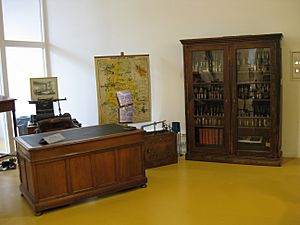Paul Sabatier (chemist) facts for kids
Quick facts for kids
Paul Sabatier
|
|
|---|---|

Sabatier in 1912
|
|
| Born | 5 November 1854 Carcassonne, France
|
| Died | 14 August 1941 (aged 86) Toulouse, France
|
| Nationality | French |
| Alma mater | Collège de France École Normale Supérieure |
| Known for | Heterogeneous catalysis |
| Awards | Nobel Prize for Chemistry (1912) Davy Medal (1915) Albert Medal (1926) Franklin Medal (1933) |
| Scientific career | |
| Fields | Inorganic chemistry |
| Institutions | Collège de France University of Bordeaux University of Toulouse |
| Doctoral advisor | Marcellin Berthelot |
Paul Sabatier (born November 5, 1854 – died August 14, 1941) was an important French chemist. He was born in a town called Carcassonne. In 1912, he won the famous Nobel Prize in Chemistry with another scientist, Victor Grignard. Sabatier was recognized for his amazing discoveries about how to add hydrogen to different chemicals using metals. This process is called hydrogenation.
Contents
Paul Sabatier's Education
Paul Sabatier started studying at the École Normale Supérieure in 1874. This was a very good school in France. Three years later, he finished at the top of his class. In 1880, he earned his Doctor of Science degree from the Collège de France.
In 1883, Sabatier took over from Édouard Filhol at the Faculty of Science. He began working closely with Jean-Baptiste Senderens. They worked so well together that it was hard to tell their work apart. They published many scientific papers together. For example, they discovered how to make methane from carbon monoxide and hydrogen in 1902. This is called the methanation reaction. In 1905, they both won the Jecker Prize for their discovery of the Sabatier–Senderens Process.
After 1905, Sabatier and Senderens worked less together. Sabatier taught science for most of his life. In 1905, he became the Dean of the Faculty of Science at the University of Toulouse.
Sabatier's Important Research
Sabatier's first research was about how heat affects sulfur and metal sulfates. This was for his doctorate degree. In Toulouse, he kept studying different chemical compounds. He also looked at how chemicals absorb light.
Sabatier made it much easier for industries to use hydrogenation. In 1897, he built on the work of American chemist James Boyce. Sabatier found that adding a tiny bit of nickel helped hydrogen combine with other carbon compounds. This tiny bit of nickel acts as a catalyst. A catalyst is something that speeds up a chemical reaction without being used up itself.
One of his most famous discoveries is the Sabatier reaction. This reaction uses a nickel catalyst to turn carbon dioxide and hydrogen into methane and water. This reaction needs high temperature and pressure to start.
- Carbon dioxide + Hydrogen → Methane + Water
This reaction is very useful! For example, it is used on the International Space Station. It helps to produce the water needed by astronauts without needing to bring it all from Earth.
Sabatier is best known for the Sabatier process and his book La Catalyse en Chimie Organique (Catalysis in Organic Chemistry), published in 1913. He won the Nobel Prize in Chemistry in 1912 for his work. He also developed the Sabatier principle of catalysis, which helps explain how catalysts work.
Paul Sabatier's Personal Life
Paul Sabatier was married and had four daughters. One of his daughters married an Italian chemist named Emilio Pomilio.
The Paul Sabatier University in Toulouse, France, is named after him. One of the high schools in his hometown of Carcassonne is also named in his honor. Paul Sabatier also helped start a science journal called the Annales de la Faculté des Sciences de Toulouse. He died in Toulouse on August 14, 1941, when he was 86 years old.
See also
- Timeline of hydrogen technologies
- In Spanish: Paul Sabatier para niños


